HGST’s Ultrastar 7K4000 is a 3.5" enterprise class HDD that ranges up to 4TB in capacity, features optional encryption and spins at 7,200RPM. The drive is designed for data centers, cloud storage, and backup and archiving. We previously reviewed the SATA 6Gb/s interface Ultrastar 7K4000 which made a splash when it was introduced due to its 33% capacity leap to 4TB as well as its 2 million hour MTBF and its solid 5 year warranty. This time around however, we’re reviewing the recently released SAS interface Ultrastar 7K4000 which broadly features a lot of the same advancements as its SATA sibling. The Ultrastar 7K4000 SAS features optional encryption, up to 4TB of storage utilizing five platters (800GB each), and superb reliability figures with its MTBF at 2.0M hours.
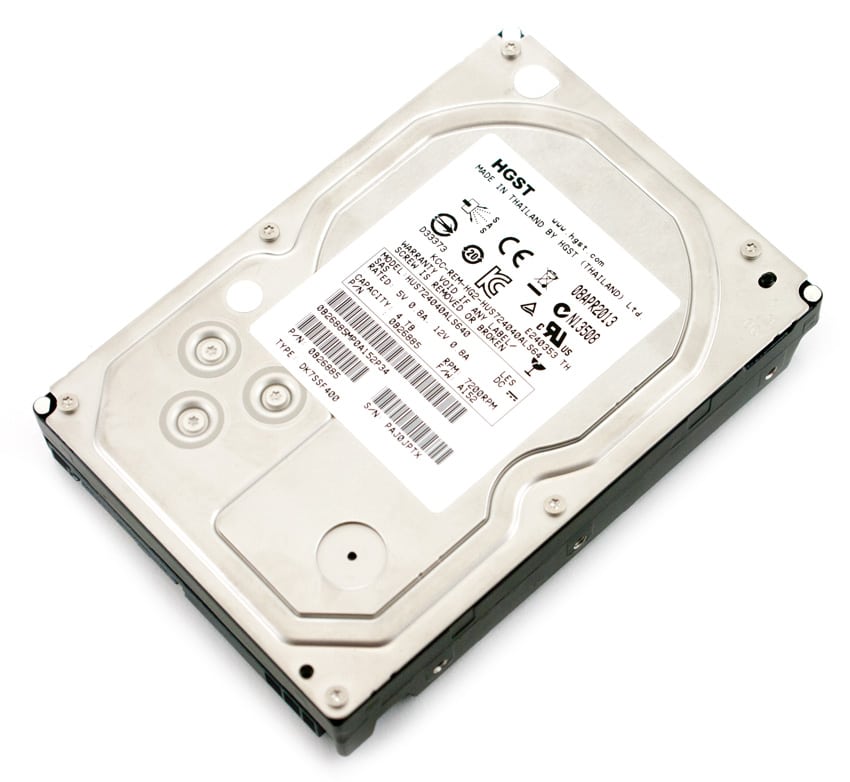
As with the Ultrastar 7K4000 SATA, the SAS model is also rated with low power consumption figures, with just marginal differences. The SATA drive was quoted at 11.4W for read/write activity versus 10.9W on the SAS model. Unload idle figures swing ever-so-slightly in favor of the SATA at 5.7W versus 6.2W. Overall, versus the previous generation 3TB model, these drives should consume about 24% less power. That’s part in thanks to the five advanced power management modes (such as low RPM idle mode). There is one fairly significant difference between the Ultrastar 7K4000 SAS and SATA is that the dual port SAS features traditional sector sizes of 512, 520 and 528 bytes. The SATA model utilizes a 4096-byte sector size (backward-compatible).
The HGST Ultrastar 7K4000 SAS is currently available and it ships with HGST’s five year standard warranty. Our test model is the non-encrypted 4TB capacity drive.
HGST Ultrastar 7K4000 Specifications
- Capacities
- 4TB – HUS724040ALS640
- 3TB – HUS724030ALS640
- 2TB – HUS724020ALS640
- Interface: SAS 6Gb/s
- Form Factor: 3.5"
- Sector size: 512/520/528
- Max. areal density (Gb/sq. in): 475
- Data buffer: 64MB
- Rotational speed (RPM): 7200
- Sustained transfer rate (typical): 172 MB/s
- Seek time (read, typical): 8.0ms
- Acoustics Idle (Bels): 2.9
- Startup current (A, max): 1.2 (+5V), 2.0 (+12V)
- Power
- Read/write: 10.9W
- Unload idle: 6.2W
- Ambient temperature: 5 to 60C
- Shock (half-sine wave): 70G
- Vibration (5 to 500 Hz): 0.67 (XYZ)
- Environmental (non-operating) Ambient temperature: -40 to 70C
- Shock (half-sine wave 1ms): 300G
- Error rate (non-recoverable, bits read): 1 in 1015
- Load/unload cycles: 600,000
- Targeted MTBF: 2 million hours
- Warranty: 5 years
- Dimensions (HxWxD): 26mm x 101.6mm (+/-0.25) x 147mm
- Weight (typical): 690g
Design and Build
The HGST Ultrastar 7K4000 SAS closely resembles its SATA sibling. In fact, outside the interface and the label, it would be extremely difficult to tell the two apart without looking at the drive interface. On the underside, users can remove the circuit board by removing seven screws, five short and two long. HGST has installed a foam pad between the drive and circuit board to help absorb vibrations.
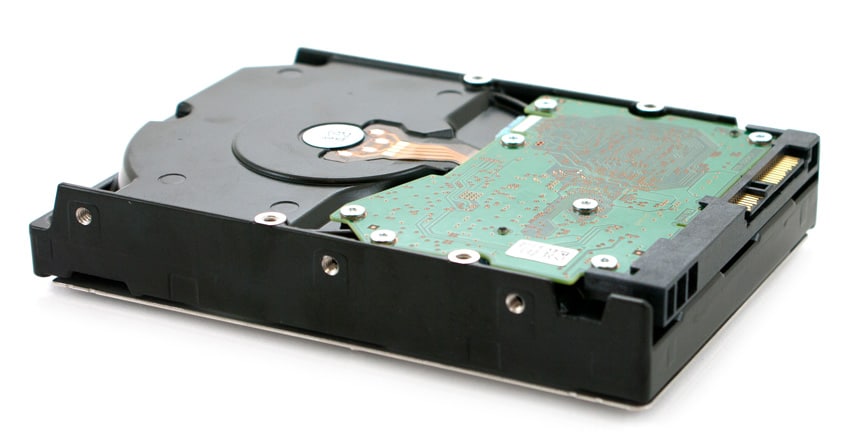
The circuit board includes an LSI controller chip, as well as 64MB of DRAM.
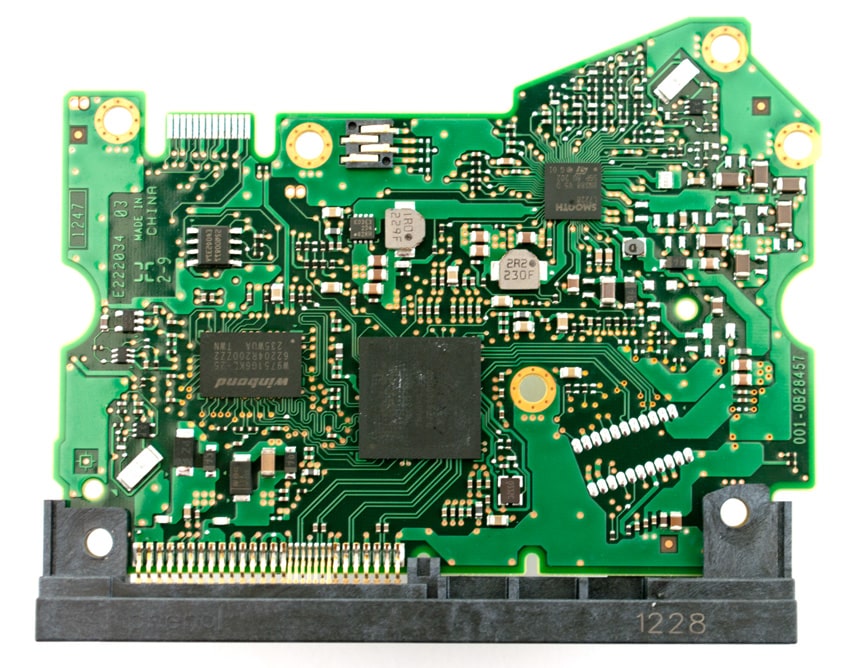
For more information about the design and build, see our HGST 7K4000 SATA Review.
Testing Background and Comparables
Comparables for this review:
- Seagate Constellation ES.3 (4TB)
- Seagate Constellation ES.2 (3TB)
- Toshiba SAS HDD MG03SCAx00 (3TB and 4TB)
All enterprise HDDs are benchmarked on our enterprise testing platform based on a Lenovo ThinkServer RD240. The ThinkServer RD240 is configured with:
- 2 x Intel Xeon X5650 (2.66GHz, 12MB Cache)
- Windows Server 2008 Standard Edition R2 SP1 64-Bit and CentOS 6.2 64-Bit
- Intel 5500+ ICH10R Chipset
- Memory – 8GB (2 x 4GB) 1333Mhz DDR3 Registered RDIMMs
- LSI 9211 SAS/SATA 6.0Gb/s HBA
Enterprise Synthetic Workload Analysis
Our enterprise hard drive benchmark process preconditions each drive into steady-state with the same workload the device will be tested with under a heavy load of 16 threads with an outstanding queue of 16 per thread, and then tested in set intervals in multiple thread/queue depth profiles to show performance under light and heavy usage. Since hard drives reach their rated performance level very quickly, we only graph out the main sections of each test.
Preconditioning and Primary Steady-State Tests:
- Throughput (Read+Write IOPS Aggregate)
- Average Latency (Read+Write Latency Averaged Together)
- Max Latency (Peak Read or Write Latency)
- Latency Standard Deviation (Read+Write Standard Deviation Averaged Together)
Our Enterprise Synthetic Workload Analysis includes four profiles based on real-world tasks. These profiles have been developed to make it easier to compare to our past benchmarks as well as widely-published values such as max 4k read and write speed and 8k 70/30, which is commonly used for enterprise drives. We also included two legacy mixed workloads, the traditional File Server and Webserver, each offering a wide mix of transfer sizes.
- 4k
- 100% Read or 100% Write
- 100% 4k
- 8k 70/30
- 70% Read, 30% Write
- 100% 8k
- 128k (Sequential)
- 100% Read or 100% Write
- 100% 128k
- File Server
- 80% Read, 20% Write
- 10% 512b, 5% 1k, 5% 2k, 60% 4k, 2% 8k, 4% 16k, 4% 32k, 10% 64k
- Webserver
- 100% Read
- 22% 512b, 15% 1k, 8% 2k, 23% 4k, 15% 8k, 2% 16k, 6% 32k, 7% 64k, 1% 128k, 1% 512k
In the first of our enterprise workloads, we measured a long sample of random 4k performance with 100% write and 100% read activity to get our main results. The HGST Ultrastar 7K4000 4TB SAS measured 245 IOPS read and 205 IOPS write. The read activity figure was edged out by the Toshiba SAS drive, however the write activity figure was able to take top honors.
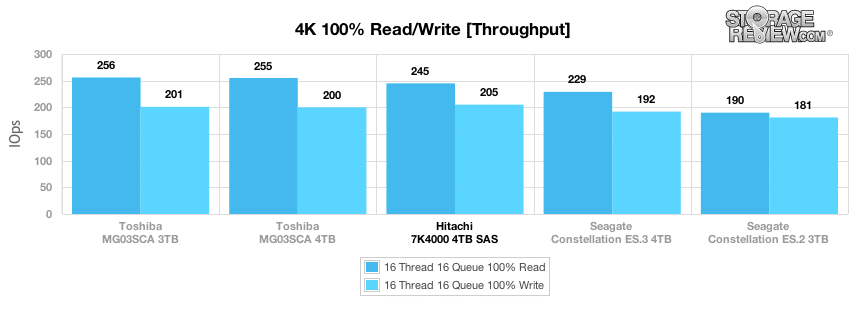
In our main average latency segment with a load of 16T/16Q, we measured an average read latency of 1043.07ms and a write latency of 1247.04ms from the HGST Ultrastar 7K4000 4TB SAS, which again was in the middle of the group.
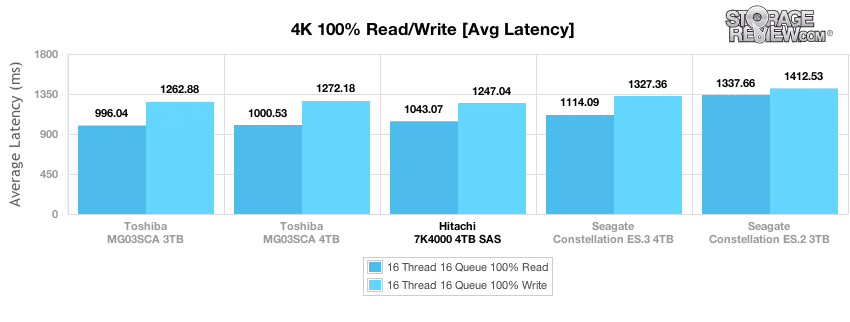
Measuring just read activity, the HGST Ultrastar 7K4000 4TB SAS had a max response time of 3761.0ms while the write activity max latency was 3069.0ms. The read activity max was near the middle of the group, though the write activity max was at the bottom.
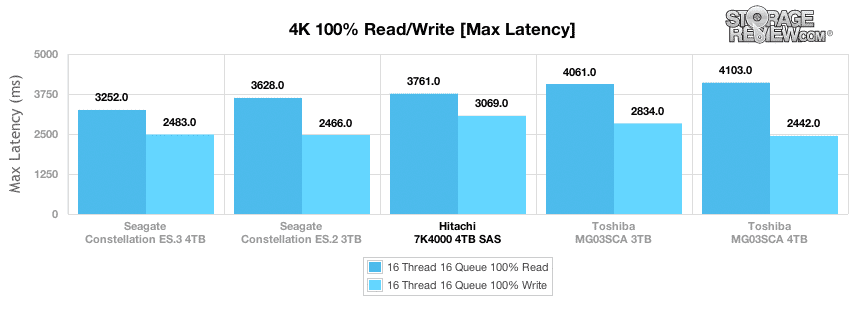
Reviewing the 4k latency consistency in our standard deviation section, the HGST Ultrastar 7K4000 4TB SAS tested at the bottom of the group with 522.95ms for read standard deviation and 404.72ms for write standard deviation.
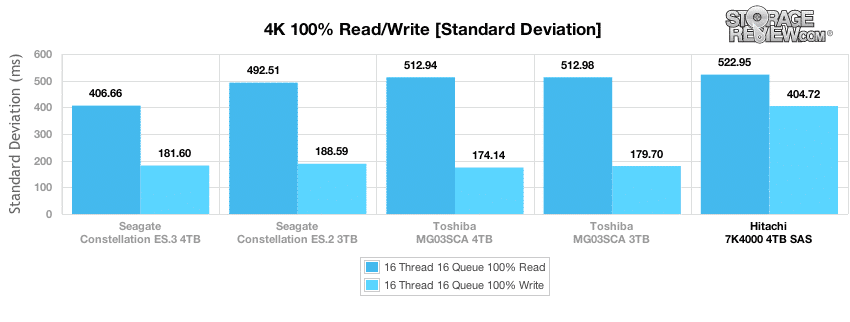
Compared to the fixed 16 thread, 16 queue max workload we performed in the 100% 4k write test, our mixed workload profiles scale the performance across a wide range of thread/queue combinations. In these tests, we span workload intensity from 2 threads and 2 queue up to 16 threads and 16 queue. In the expanded 8k 70/30 test, the HGST Ultrastar 7K4000 4TB SAS came in just under the Toshiba SAS drives with competitive throughput that nearly did match Toshiba’s. It reached up to 225 IOPS, with 222 IOPS in the terminal queue depth.
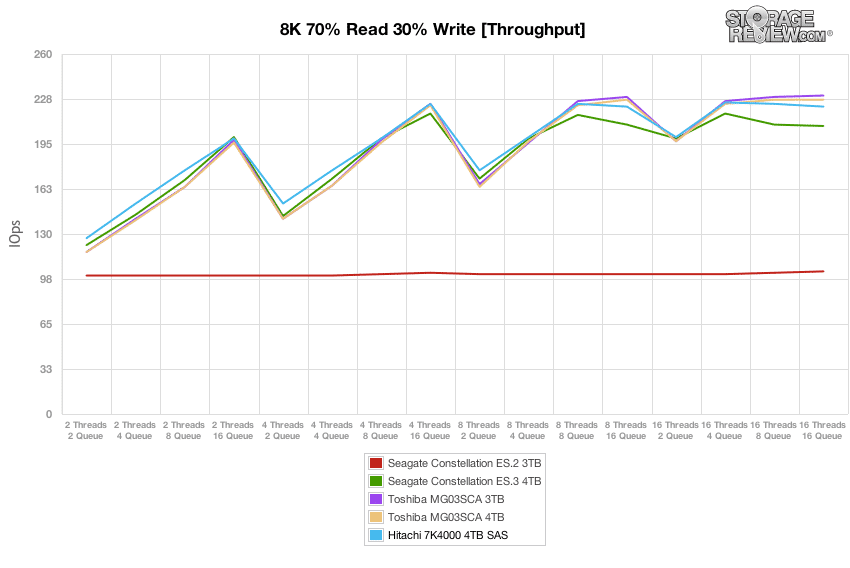
Looking over the 8k 70/30 average response times, the HGST Ultrastar 7K4000 4TB SAS stayed close to the Toshiba SAS drives again, but was eventually just beat out.
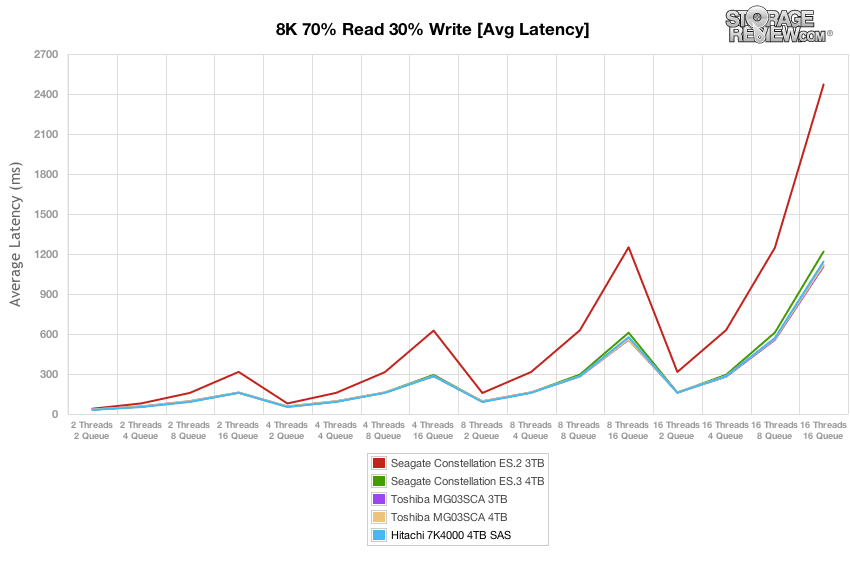
Over the duration of our primary tests at varying thread and queue depth levels, the HGST Ultrastar 7K4000 4TB SAS had competitive max latency with the second lowest max latency at 303ms for the 2 threads and 2 queue depth level and the second lowest max latency at the 16 thread and 16 queue depth level at 3,575ms.
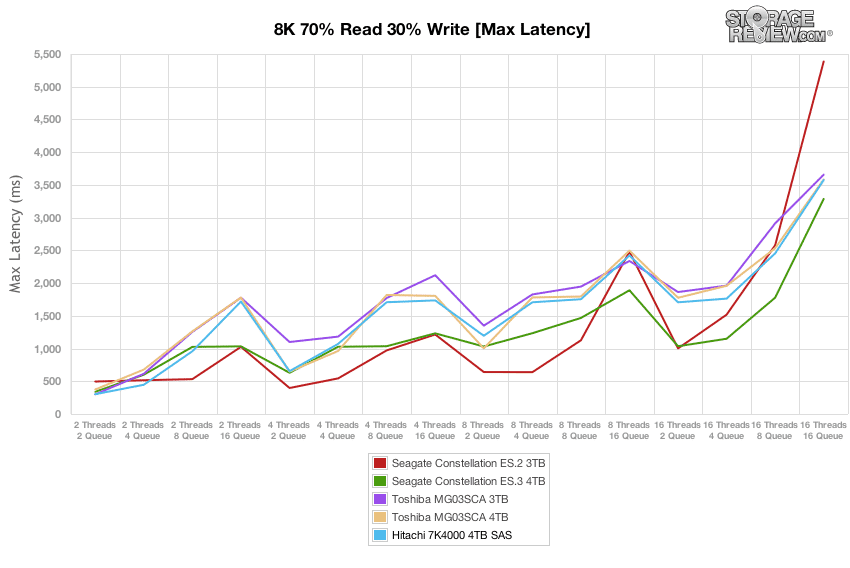
For the majority of the thread/queue spectrum, the HGST Ultrastar 7K4000 4TB SAS maintained latency higher than most or all of the competition.
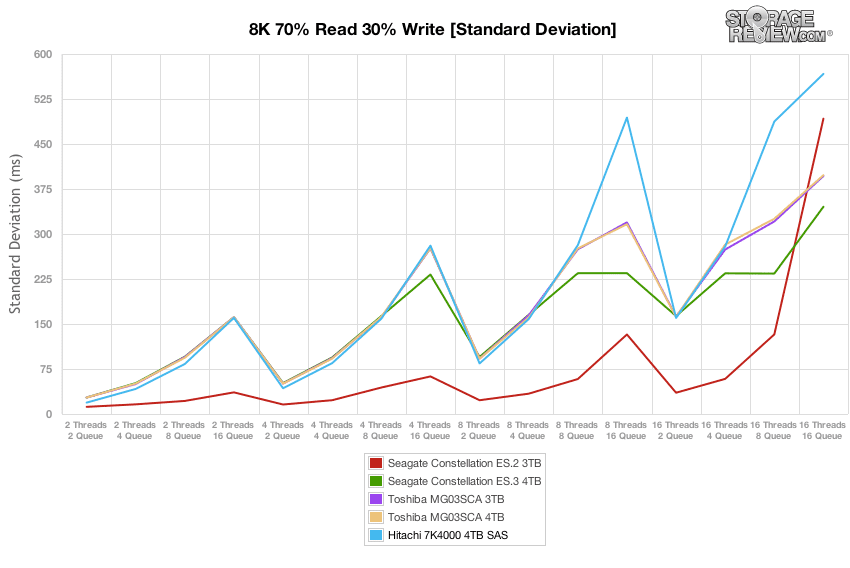
In our 128k test, which is a large block sequential test that shows the highest sequential transfer speed for a platter drive, we look at the 128k performance with 100% write and 100% read activity. Here, the HGST Ultrastar 7K4000 4TB SAS performed well, only getting edged out by the Seagate Constellation ES.3 4TB. The HGST Ultrastar 7K4000 4TB SAS posted 177,740KB/s read and 177,780KB/s write.
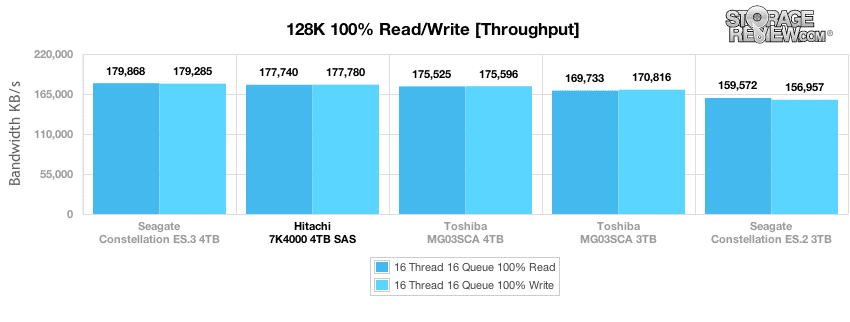
The next workload we used is our File Server profile which puts the drives through a varying workload. We scaled the thread and queue count from 2T/2Q up to 16T/16Q. Under this range of workloads, the HGST Ultrastar 7K4000 4TB SAS ranked near the top of the group at a max of 231 IOPS, just under the Toshiba SAS 3TB which hit 234 IOPS.
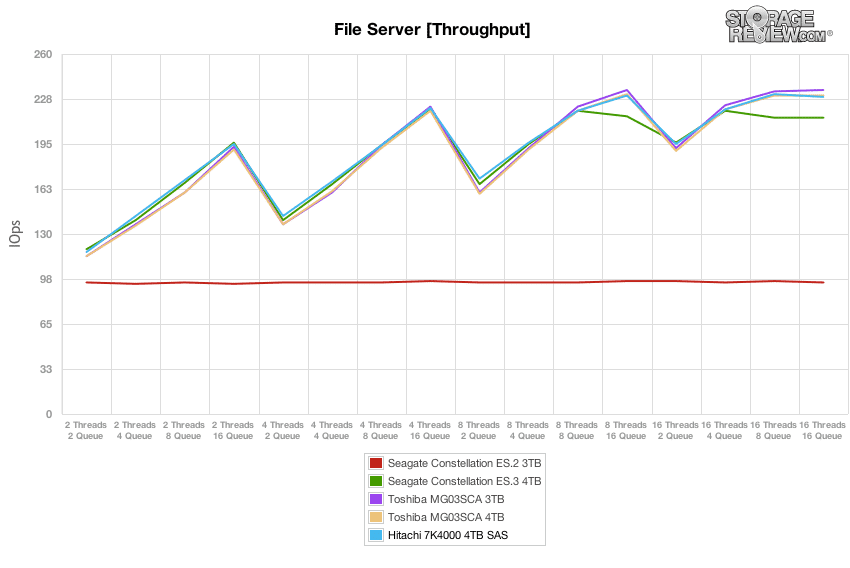
At all queue depths, the HGST Ultrastar 7K4000 4TB SAS was neck and neck with the Toshiba SAS drives, though it was beat out with terminal queue reading at 1,115ms.
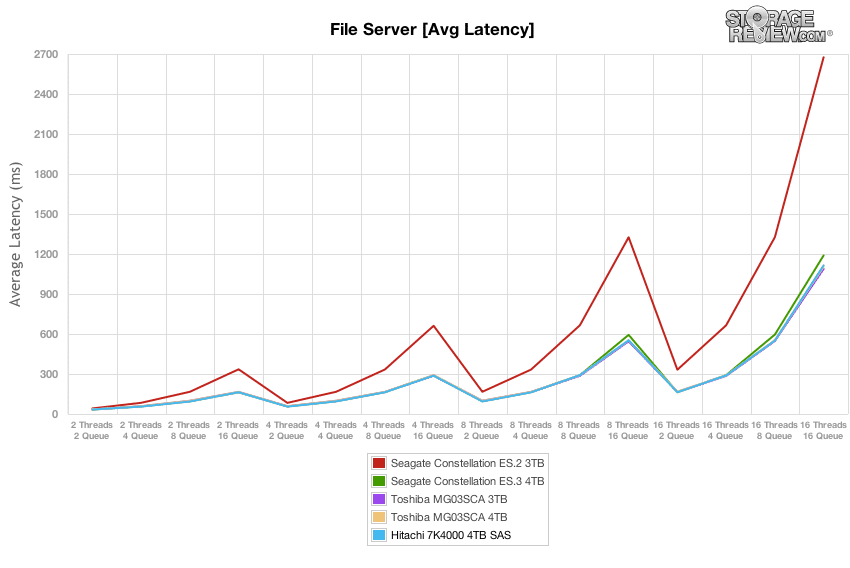
Comparing peak response times in our File Server profile, the HGST Ultrastar 7K4000 4TB SAS was a strong competitor, edged out only by the Seagate Constellation ES.3 4TB.
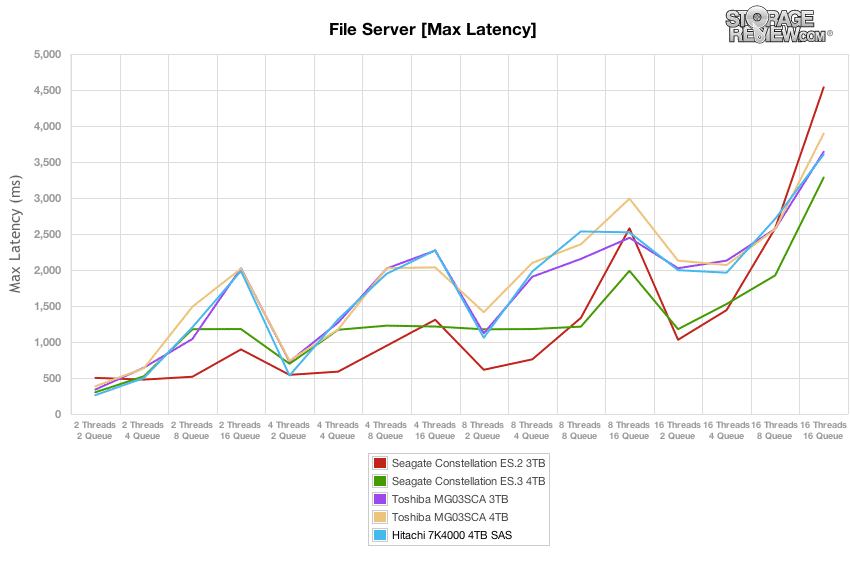
Looking at the latency standard deviation, the HGST Ultrastar 7K4000 4TB SAS fell to the back of the group again.
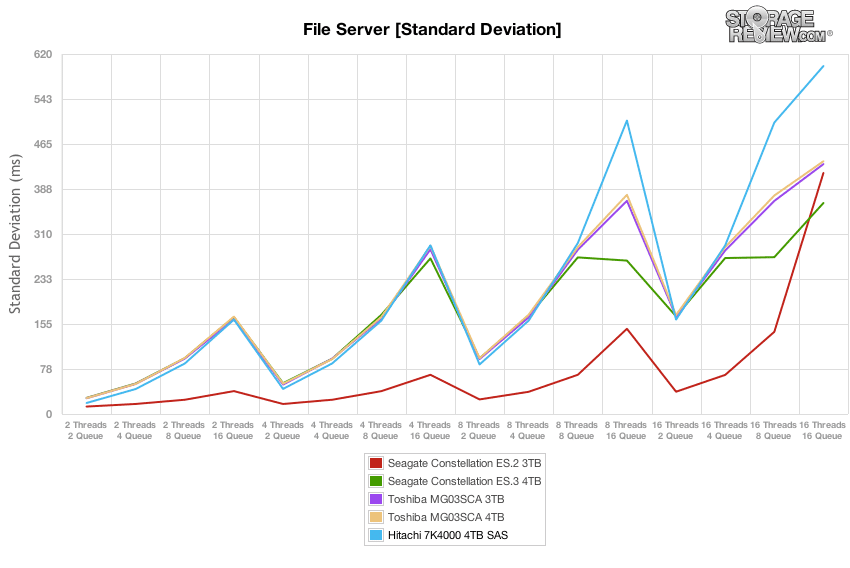
Our final test is the Web Server test, which is traditional 100% read activity. The HGST Ultrastar 7K4000 4TB SAS peaked at 240 IOPS at 16T8Q and had a terminal queue depth reading at 239 IOPS. That placed it just below the Toshiba SAS drives.
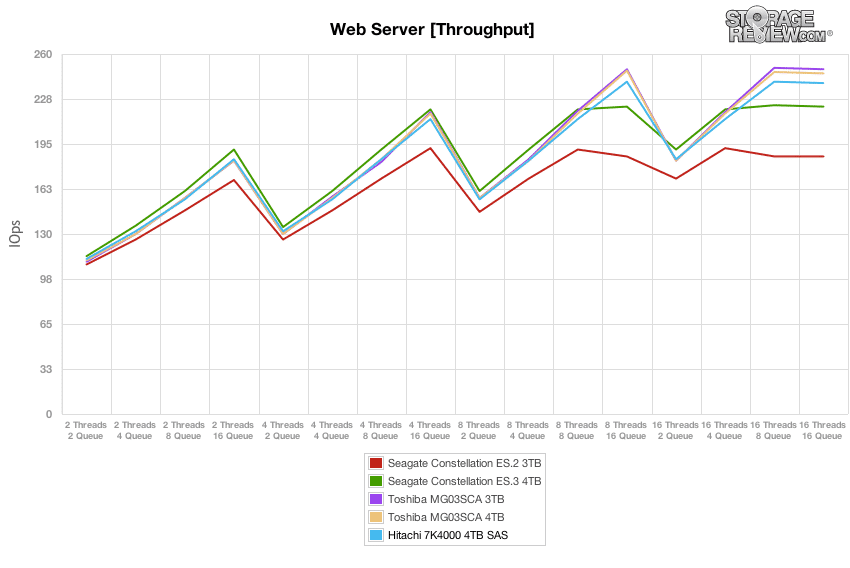
The HGST was again just edged out by the Toshiba SAS drives in our next test of average latency in the Web Server profile.
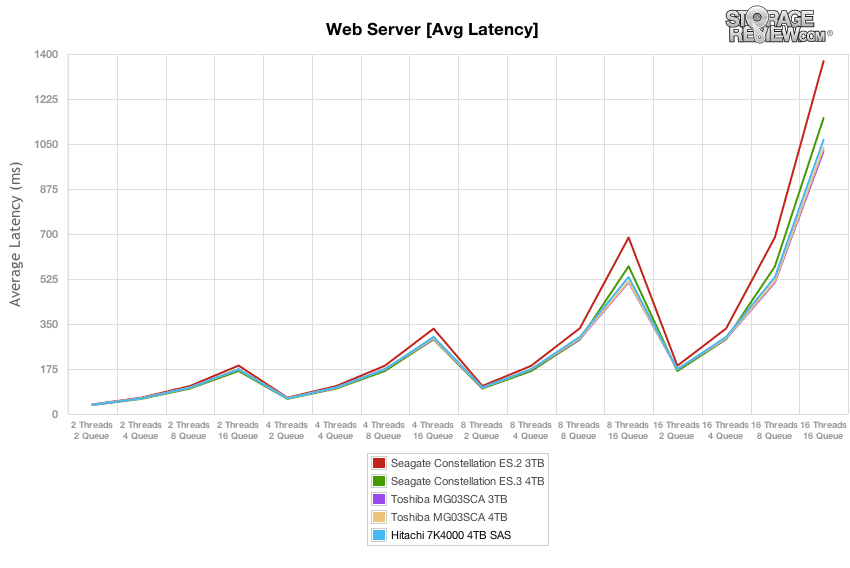
Looking at Max Latency in our Web Server profile, the HGST Ultrastar 7K4000 4TB SAS was in the middle of the group at 4094ms.
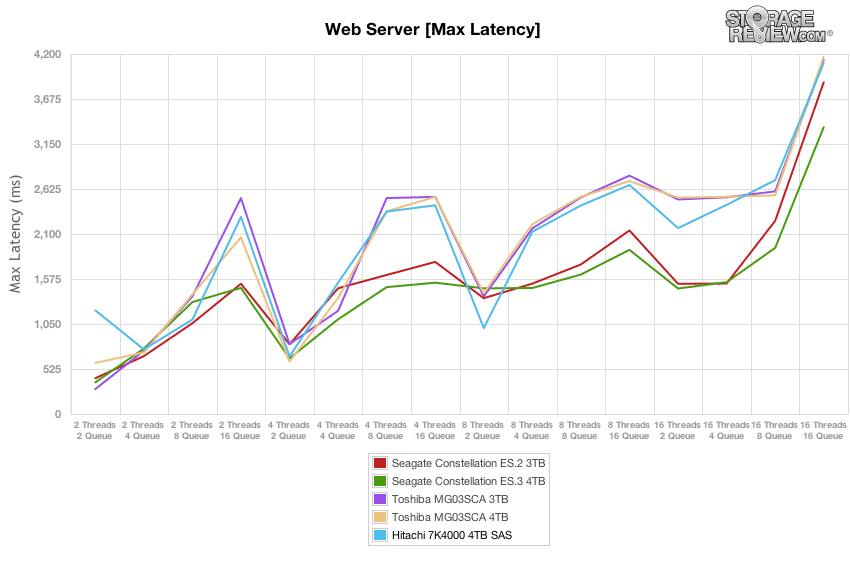
Comparing latency consistency in our read-only Web Server profile, the HGST Ultrastar 7K4000 4TB SAS again found itself at the bottom of the group in this category.
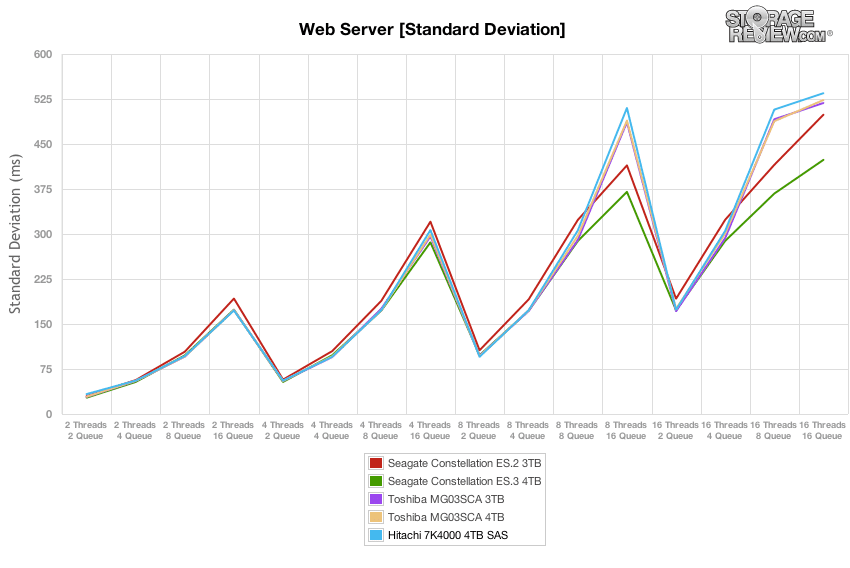
Conclusion
The HGST Ultrastar 7K4000 SAS HDD is an enterprise class drive that utilizes up to five platters to achieve 4TB of storage capacity. Spinning at 7,200RPM, the drive also features the reliability figures organizations involved in cloud and data center storage require (MTBF at 2.0M hours). The drive is also optimized to meet those application needs with its included advanced power management modes which offer 5 profiles such as low RPM idle to drive a lower TCO. The drive is rated at 10.9W for read/write activity, 6.2W for unload idle, and at less than 2W for sleep and standby modes.
Looking at testing for the HGST Ultrastar 7K4000 SAS HDD, the drive performed well overall. In all testing (4k, 8k, 128k, file server and web server), the Ultrastar 7K4000 SAS produced consistent throughput which was often second in the group. While not blowing away the competition, the fact that the drive performed so consistently says quite a bit. Additionally, the same can be said about its average latency figures. On a less than positive note, the drive’s standard deviation figures were generally at the bottom of the group. However, that doesn’t necessarily reflect that the drive produced the peakiest latency. In fact, the Ultrastar 7K4000 SAS placed in the upper half of the group in max and average latency most of the time. These throughput and latency figures matched with the Ultrastar 7K4000 SAS’s warranty and MTBF specs provide enterprises with a very capable drive.
Pros
- Throughput figures measured near the top of the group across all categories
- Strong sequential transfer speeds
- 2 million hour MTBF is class leading
Cons
- Competing SAS HDDs edged out the 7K4000 in latency standard deviation
Bottom Line
The HGST Ultrastar 7K4000 SAS HDD has a strong 2 million hour MTBF and 5 year warranty to assure buyers of its reliability, and through our testing we’ve found that HGST also delivers consistently high throughput in both random and sequential workloads.




 Amazon
Amazon